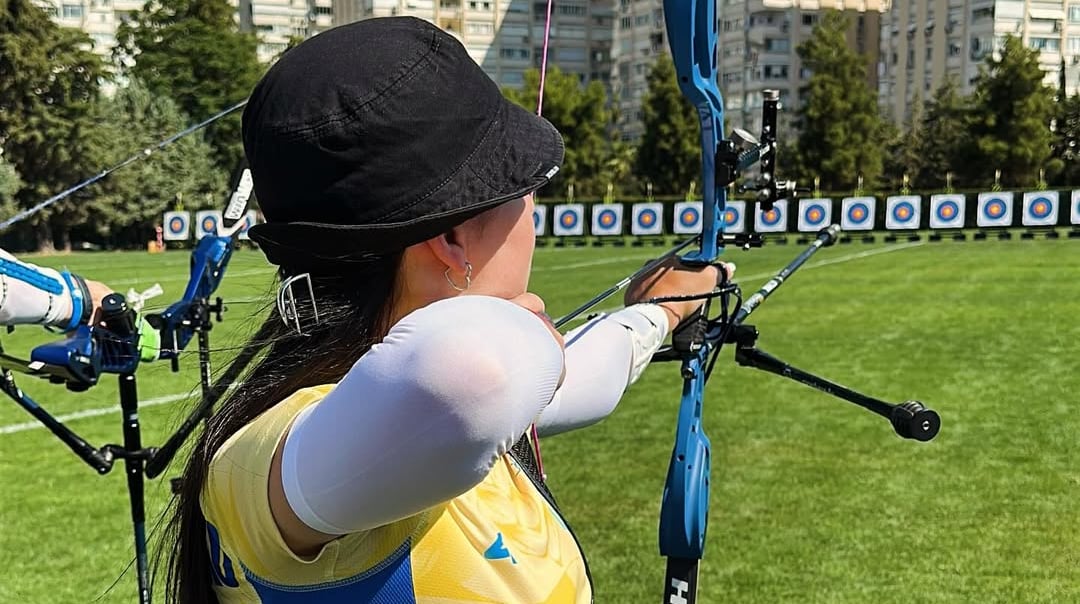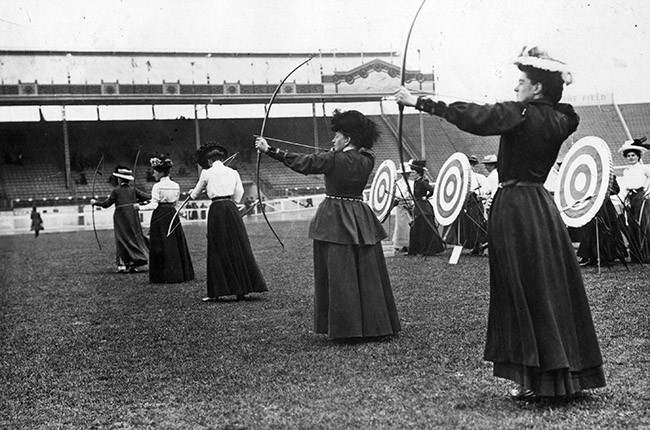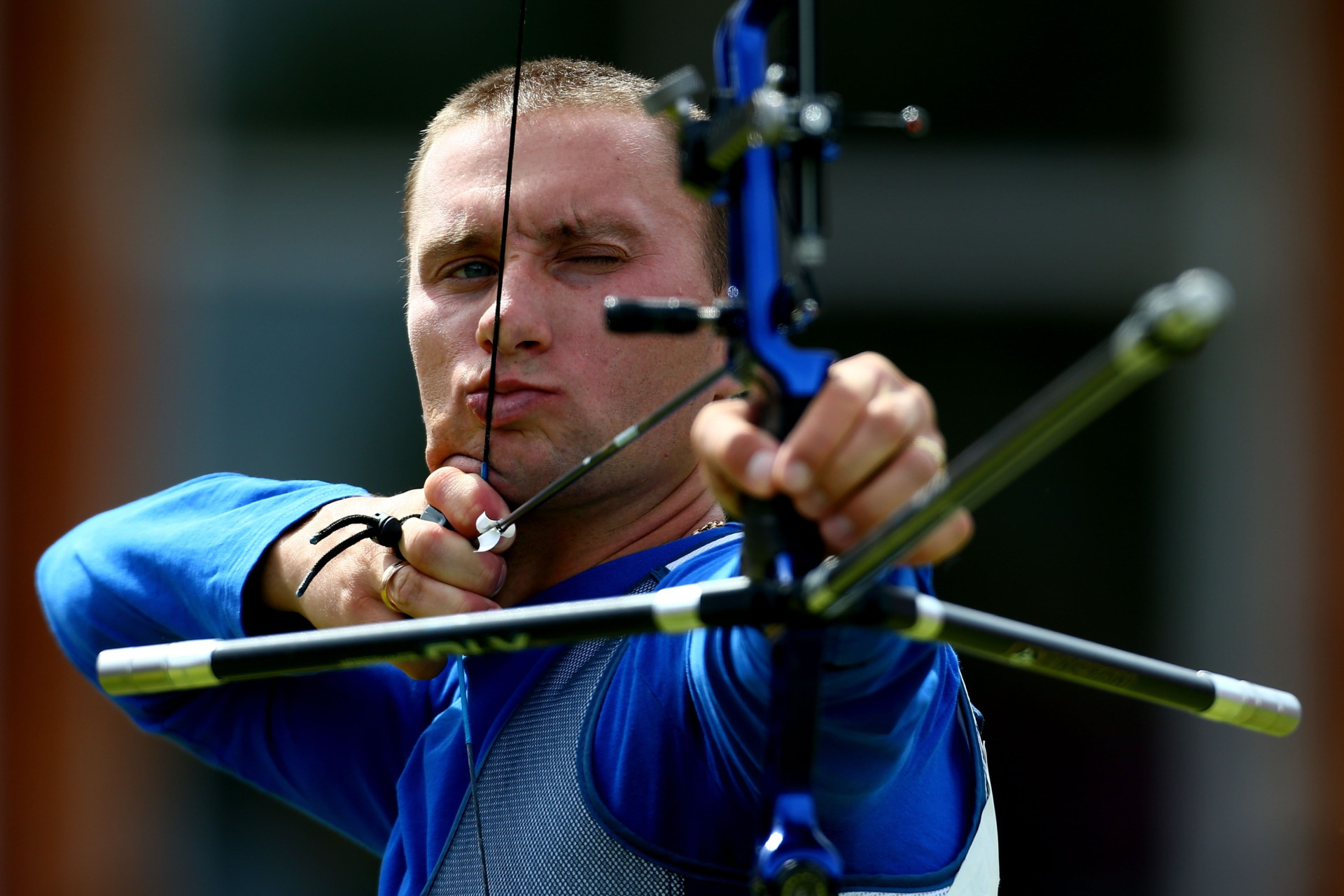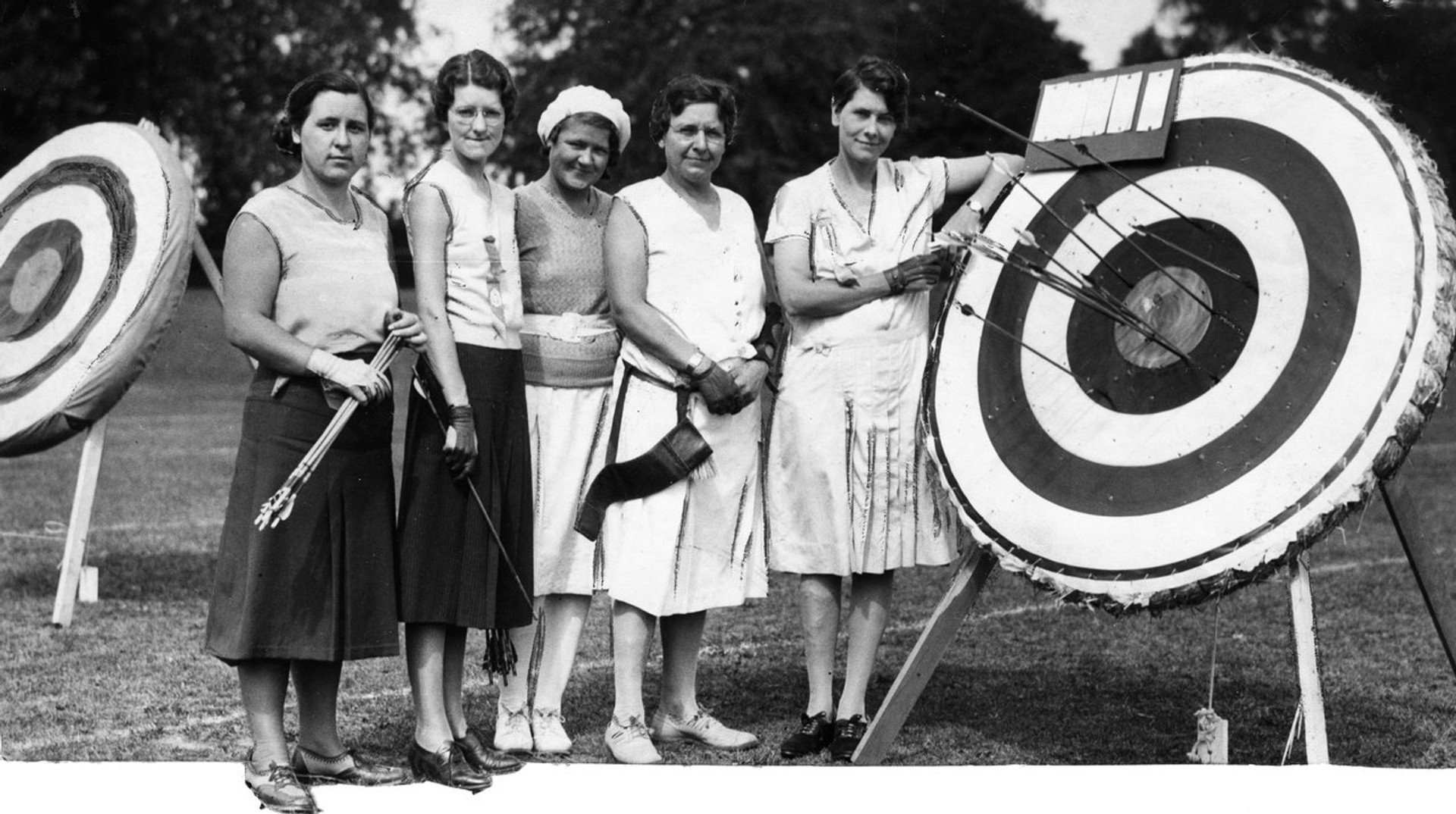“
Shooting from Luke as sports originates in Europe since 1844 (United Kingdom), and in the United States-since 1879. At the end XIX There were 50 rifle clubs in the United Kingdom.

Luke shooting was part of the Olympic Games Program 1900, 1904, 1908 and 1920. However, due to the small number of national teams that participated in the competition (did not exceed three despite the fact that in 1920, 10 sets of awards were played in Antwerp in Antwerp), and because of the discrepancy in the rules of competition in different countries, this sport was removed from the Olympic program for some time in 1924.
 Luke Shooting Competition, Olympic Games 1908 in London
Luke Shooting Competition, Olympic Games 1908 in LondonIn the late 1920s, enthusiasts from the countries where the archery developed, decided to create an international federation to unify the rules, hold tournaments to identify the best athletes in the world and return archery from the Luke to the Olympic Games Program.
On the initiative of the Polish Union of archers, from August 23 to September 2, 1931, the first World Cup was held in Lviv. After the tournament, on September 4, the First Congress of the International Federation of Luke was held.
But everything in turn.
Championship A good tugboat for these events was the International Federation of Bullet and Hunting Shooting, which regularly conducted its World Cups (since 1897).
Luke sports archery emerged in Poland in the early 1920s after returning from South America, Officer Meczyslaw Fulersky. He spent a long time among the tribes of the Indians in Brazil and learned to shoot there. Officially, the Union of Lucici Związek łuczniczy was established on February 7, 1927 in Warsaw.
In October 1929, in Warsaw, at the National Conference of the Ministry of Military Affairs and the Department of Physical Education, it was decided to hold large national competitions in Lviv in 1930, and in 1931 to hold a large International Infantry Tournament. Later, he received the status of the 28th World Championships in Kulova and Hunting Shooting, as well as the First Luke World Championship. The patronage of the World Cup was carried out by the Minister of Military Affairs Marshal Joseph Pilsudski.
Since Warsaw did not have the appropriate facility, Lviv was chosen by Lviv. Here on Kleparov (where now the SKA sports complex) was built modernist, as a time: seven for balls, whose competition program was very wide, two – for hunters (stands), and one – for archers who decided to join the balls and hunters.
The meadow field had a hundred meters long, at each end of the field there were eight shields. Then this shooting complex, which also had rooms for recreation and storage of weapons, premises for the Judicial College and journalists, considered the best in Europe.
22 athletes from four countries – Poland, Sweden, Czechoslovakia and France – participated in the archers. Shooting was at a distance of 30, 40 and 50 meters in diameter of 80 cm. They competed in individual and team shooting (without dividing into male and women’s categories, among the participants were 8 women – seven from Poland and one of Czechoslovakia).
In the individual shooting the champion was Pole Michal Savitsky – 478 points. The second place was won by Polka Yanina Kurkovskaya (467 points), Bronze was won by Frenchman Rene Alexander (455 points). In team competitions (as part of the team of three athletes) the French (1277) became the champions, the second place was won by the Men’s Team of Poland (1245), the third – the women’s Polish team (1163).
By the way, 51-year-old Gaston Kinten was composed of the French team, who won 4 medals at the 1920 Olympics (3 silver and 1 bronze). In individual competitions in Lviv, it became the fifth.
The tournament aroused great interest in Lviv residents and gathered many viewers. The participants of the championship were very much liked by the cultural program, which was prepared by the owners of the competition. The athletes were shown the outskirts of Lviv, the Carpathian Mountains, the High Castle, the famous panorama of Raclavitsk in Stryi Park (The battle of Kostyushko’s troops in 1794), etc.
 Luke shooting competitions, Lviv, 1931
Luke shooting competitions, Lviv, 1931Federation On September 4, 1931, representatives of 7 national federations (Italy, Poland, USA, Hungary, France, Czechoslovakia, Sweden) founded the International Federation of Luka Infantry in the meeting room of the Lviv City Hall. Traditionally, the name of the federation was given in French – Fita (Fita) from Fédération Internationale de Tir à L’RC: International Luke Federation. Gaston Kingen, Vice president of the Federation Federation from Luke France, chaired at the congress.
The first president of Fit was chosen by the captain of the Polish Army Meczyslaw Fulersky. Vice president and members of the Fita Council were also elected and its charter was approved. At the proposal of Fulersky, a membership fee was assigned from each national federation in the amount of 250 francs.
Due to the employment in the military service of Mechislav Fullyansky, another Poland representative – Bronislav Pezhhal (he was the sole competitor of Fullyansky in the elections and lost to him: 3 votes against 4). Pezhhala performed the functions of President Fit until 1946.
During the celebrations of the 80th anniversary of Fita in July 2011, it was decided to rename the Federation to Wa (from English World Archery).
Today, Wa brings together 159 national federations. President Wa – Ugur Erder (Turkey, since 2005). The headquarters is in Lausanne (Switzerland). It should be noted that Ugur Erdener has been the President of the NOC of Turkey since 2011 and is also the Vice President of the IOC.
Every two years (in the odd years), Fita holds the World Cups. The nearest championship will be held soon, September 5-12, in Kwwanda (Republic of Korea). Participants will be representatives of Ukraine.
Ukrainian trace Even before the Second World War, four representatives of Lviv became champions of the world. Myron Trush, an ethnic Ukrainian, grandson of Mikhail Drahomanov, won in the Polish national team in 1937 in Paris. Bruno Prugar won the firing competition at the moving target. The following year, Lyudmila Dubai and Casimir Svister, in London, as part of the World Champions of the World Women’s Team.
Bruno Prugar belonged to a family who lived in Lviv for several generations and produced a wide range of wooden products. Their factory was located on Supinsky Street, 7 (now Kotsyubynsky Street). Grandfather of Champion, Martsin Prugar, made wooden window frames and doors; Father, Tadeusz Prugar, expanded the range of products, including skis. And Bruno himself mastered the production of bows. The equipment produced by the factory of reprisals was so high quality that in 1939 it received a certificate of the World Exhibition In New York…
Modern Luke sports shooting has been developing in Ukraine since the second half of the 1950s. The origins were a Lviv athlete, coach and inventor Mykola Kalinichenko, a pistol shooting champion. He became fascinated with Luke, seeing demonstrations at the Youth and Students Festival in Moscow (1957). Kalinichenko became the first champion of the USSR and how a coach brought up a number of prominent masters.
Since then, many medals have been conquered by Ukrainian archers, victories have been won and the records of the European, World and Olympiad Championships have been set, and various Luke firing techniques have been developed.
In the Soviet period, when the USSR national team made its debut at the World Championships, in 1969 in Vella Fran (USA), the first Soviet world champions in the team were the Lviv residents Nonna Kozina and Tatiana Obraztsov. In 1973, the world championship in French Grenoble was won by Victor Sidoruk, who later became one of the most famous coaches in the world: he was the mentor of national national teams of the USSR, Spain, Italy and Ukraine. Valentina Kopan, Lviv, became the World Champion in the team (1975, Interlagen, Switzerland), and in 1976 she won the first Ukrainian Olympic medal in Montreal – silver.
In 1989, at the World Cup in Lausana, Kharkiv Stanislav Zabrodsky won gold in personal and team competitions.
The first Olympic awards were won in Atlanta-1996: Olena Sadovnichi won bronze in his personal standings in Atlanta. In 2000, in Sydney, the women’s team, consisting of Elena Sadovnychi, Odessa Natalie Bordayna, Kharkiv Kateryna Sumko, won silver team standings. In Athens-2004, the men’s team (Kharkiv Victor Ruban and Oleksandr Serdyuk and Lviv Dmitry Grachov) received a team bronze. In 2008, Victor Ruban won the first and the only Ukrainian Olympic gold in his personal standings in Beijing.
 Victor Ruban, London 2012
Victor Ruban, London 2012
Getty Images
At the 2015 World Cup in Copenhagen, the Ukrainian Women’s Team (Olena Borisenko, Victoria Dyakova, Maria Shkolna) won gold in Bloch Luke. Also, from 1995 to 2009, Ukrainians won 2 silver and 4 bronze awards at the World Championships.
From 1992 to 2016, our athletes won 4 gold, 4 silver and 6 bronze awards from 1992 to 2016.
Ukrainian archers also successfully performed at the world championships in closed premises, which Fita spent in 1991-2018 years. The champions were Tatiana Muntyan (1997), Natalia Burdain (2005), Georgy Ivanytsky (2016), women’s team (1995, 2003, 2014), men’s team (2005, 2014).
Many Ukrainian coaches worked fruitfully abroad. In particular, former Viktor Predokhin was the first coach of the World and European Champion of Europe and Europe, the Olympic Olympic Rustamo (Tajikistan). And the couple of Igor and Igor Orlikov prepared several times the champion and record holder of the world and Europe, the Olympic medalist Natalia Valeyev.
The development of archery in Ukraine is the care of the National Federation, founded in 1992. Since the same year, the All -Ukrainian Luke Federation has been a member of the International Federation of Luke (Fita) and the European and Mediterranean Union of Luke (EMAU, since 2014 World Archery Europe). President of the UFSL – Alexander Nikolaevsky.
The main centers of firing from Luke in Ukraine were historically Kharkiv, Lviv, Chernivtsi, Nova Kakhovka. During the full -scale war and Russian aggression, leading coaches and athletes from Kharkiv and Nova Kakhovka were relocated to the west of Ukraine – Lviv, Chernivtsi and other cities. Despite all the difficulties, Ukrainian archers work constantly and hope to successfully continue the glorious historical traditions.
”, – WRITE: Champion.com.ua
Shooting from Luke as sports originates in Europe since 1844 (United Kingdom), and in the United States-since 1879. At the end XIX There were 50 rifle clubs in the United Kingdom.

Luke shooting was part of the Olympic Games Program 1900, 1904, 1908 and 1920. However, due to the small number of national teams that participated in the competition (did not exceed three despite the fact that in 1920, 10 sets of awards were played in Antwerp in Antwerp), and because of the discrepancy in the rules of competition in different countries, this sport was removed from the Olympic program for some time in 1924.
 Luke Shooting Competition, Olympic Games 1908 in London
Luke Shooting Competition, Olympic Games 1908 in LondonIn the late 1920s, enthusiasts from the countries where the archery developed, decided to create an international federation to unify the rules, hold tournaments to identify the best athletes in the world and return archery from the Luke to the Olympic Games Program.
On the initiative of the Polish Union of archers, from August 23 to September 2, 1931, the first World Cup was held in Lviv. After the tournament, on September 4, the First Congress of the International Federation of Luke was held.
But everything in turn.
Championship A good tugboat for these events was the International Federation of Bullet and Hunting Shooting, which regularly conducted its World Cups (since 1897).
Luke sports archery emerged in Poland in the early 1920s after returning from South America, Officer Meczyslaw Fulersky. He spent a long time among the tribes of the Indians in Brazil and learned to shoot there. Officially, the Union of Lucici Związek łuczniczy was established on February 7, 1927 in Warsaw.
In October 1929, in Warsaw, at the National Conference of the Ministry of Military Affairs and the Department of Physical Education, it was decided to hold large national competitions in Lviv in 1930, and in 1931 to hold a large International Infantry Tournament. Later, he received the status of the 28th World Championships in Kulova and Hunting Shooting, as well as the First Luke World Championship. The patronage of the World Cup was carried out by the Minister of Military Affairs Marshal Joseph Pilsudski.
Since Warsaw did not have the appropriate facility, Lviv was chosen by Lviv. Here on Kleparov (where now the SKA sports complex) was built modernist, as a time: seven for balls, whose competition program was very wide, two – for hunters (stands), and one – for archers who decided to join the balls and hunters.
The meadow field had a hundred meters long, at each end of the field there were eight shields. Then this shooting complex, which also had rooms for recreation and storage of weapons, premises for the Judicial College and journalists, considered the best in Europe.
22 athletes from four countries – Poland, Sweden, Czechoslovakia and France – participated in the archers. Shooting was at distances 30, 40 and 50 meters in diameter of 80 cm. Competition in individual and team shooting (without division into male and women’s categories, among the participants were 8 women – seven from Poland and one of Czechoslovakia).
In the individual shooting the champion was Pole Michal Savitsky – 478 points. The second place was won by Polka Yanina Kurkovskaya (467 points), Bronze was won by Frenchman Rene Alexander (455 points). In team competitions (as part of the team of three athletes) the French (1277) became the champions, the second place was won by the Men’s Team of Poland (1245), the third – the women’s Polish team (1163).
By the way, 51-year-old Gaston Kinten was composed of the French team, who won 4 medals at the 1920 Olympics (3 silver and 1 bronze). In individual competitions in Lviv, it became the fifth.
The tournament aroused great interest in Lviv residents and gathered many viewers. The participants of the championship were very much liked by the cultural program, which was prepared by the owners of the competition. The athletes were shown the outskirts of Lviv, the Carpathian Mountains, the High Castle, the famous panorama of Raclavitsk in Stryi Park (The battle of Kostyushko’s troops in 1794), etc.
 Luke shooting competitions, Lviv, 1931
Luke shooting competitions, Lviv, 1931Federation On September 4, 1931, representatives of 7 national federations (Italy, Poland, USA, Hungary, France, Czechoslovakia, Sweden) founded the International Federation of Luka Infantry in the meeting room of the Lviv City Hall. Traditionally, the name of the federation was given in French – Fita (Fita) from Fédération Internationale de Tir à L’RC: International Luke Federation. Gaston Kingen, Vice president of the Federation Federation from Luke France, chaired at the congress.
The first president of Fit was chosen by the captain of the Polish Army Meczyslaw Fulersky. Vice president and members of the Fita Council were also elected and its charter was approved. At the proposal of Fulersky, a membership fee was assigned from each national federation in the amount of 250 francs.
Due to the employment in the military service of Mechislav Fullyansky, another Poland representative – Bronislav Pezhhal (he was the sole competitor of Fullyansky in the elections and lost to him: 3 votes against 4). Pezhhala performed the functions of President Fit until 1946.
During the celebrations of the 80th anniversary of Fita in July 2011, it was decided to rename the Federation to Wa (from English World Archery).
Today, Wa brings together 159 national federations. President Wa – Ugur Erder (Turkey, since 2005). The headquarters is in Lausanne (Switzerland). It should be noted that Ugur Erdener has been the President of the NOC of Turkey since 2011 and is also the Vice President of the IOC.
Every two years (in the odd years), Fita holds the World Cups. The nearest championship will be held soon, September 5-12, in Kwwanda (Republic of Korea). Participants will be representatives of Ukraine.
Ukrainian trace Even before the Second World War, four representatives of Lviv became champions of the world. Myron Trush, an ethnic Ukrainian, grandson of Mikhail Drahomanov, won in the Polish national team in 1937 in Paris. Bruno Prugar won the firing competition at the moving target. The following year, Lyudmila Dubai and Casimir Svister, in London, as part of the World Champions of the World Women’s Team.
Bruno Prugar belonged to a family who lived in Lviv for several generations and produced a wide range of wooden products. Their factory was located on Supinsky Street, 7 (now Kotsyubynsky Street). Grandfather of Champion, Martsin Prugar, made wooden window frames and doors; Father, Tadeusz Prugar, expanded the range of products, including skis. And Bruno himself mastered the production of bows. The equipment produced by the factory of reprisings was so high quality that in 1939 it received a certificate of the World Exhibition in New York …
Modern Luke sports shooting has been developing in Ukraine since the second half of the 1950s. The origins were a Lviv athlete, coach and inventor Mykola Kalinichenko, a pistol shooting champion. He became fascinated with Luke, seeing demonstrations at the Youth and Students Festival in Moscow (1957). Kalinichenko became the first champion of the USSR and how a coach brought up a number of prominent masters.
Since then, many medals have been conquered by Ukrainian archers, victories have been won and the records of the European, World and Olympiad Championships have been set, and various Luke firing techniques have been developed.
In the Soviet period, when the USSR national team made its debut at the World Championships, in 1969 in Vella Fran (USA), the first Soviet world champions in the team were the Lviv residents Nonna Kozina and Tatiana Obraztsov. In 1973, the world championship in French Grenoble was won by Victor Sidoruk, who later became one of the most famous coaches in the world: he was the mentor of national national teams of the USSR, Spain, Italy and Ukraine. Valentina Kopan, Lviv, became the World Champion in the team (1975, Interlagen, Switzerland), and in 1976 she won the first Ukrainian Olympic medal in Montreal – silver.
In 1989, at the World Cup in Lausana, Kharkiv Stanislav Zabrodsky won gold in personal and team competitions.
The first Olympic awards were won in Atlanta-1996: Olena Sadovnichi won bronze in his personal standings in Atlanta. In 2000, in Sydney, the women’s team, consisting of Elena Sadovnychi, Odessa Natalie Bordayna, Kharkiv Kateryna Sumko, won silver team standings. In Athens-2004, the men’s team (Kharkiv Victor Ruban and Oleksandr Serdyuk and Lviv Dmitry Grachov) received a team bronze. In 2008, Victor Ruban won the first and the only Ukrainian Olympic gold in his personal standings in Beijing.
 Victor Ruban, London 2012
Victor Ruban, London 2012
Getty Images
At the 2015 World Cup in Copenhagen, the Ukrainian Women’s Team (Olena Borisenko, Victoria Dyakova, Maria Shkolna) won gold in Bloch Luke. Also, from 1995 to 2009, Ukrainians won 2 silver and 4 bronze awards at the World Championships.
From 1992 to 2016, our athletes won 4 gold, 4 silver and 6 bronze awards from 1992 to 2016.
Ukrainian archers also successfully performed at the world championships in closed premises, which Fita spent in 1991-2018 years. The champions were Tatiana Muntyan (1997), Natalia Burdain (2005), Georgy Ivanytsky (2016), women’s team (1995, 2003, 2014), men’s team (2005, 2014).
Many Ukrainian coaches worked fruitfully abroad. In particular, former Viktor Predokhin was the first coach of the World and European Champion of Europe and Europe, the Olympic Olympic Rustamo (Tajikistan). And the couple of Igor and Igor Orlikov prepared several times the champion and record holder of the world and Europe, the Olympic medalist Natalia Valeyev.
The development of archery in Ukraine is the care of the National Federation, founded in 1992. Since the same year, the All -Ukrainian Luke Federation has been a member of the International Federation of Luke (Fita) and the European and Mediterranean Union of Luke (EMAU, since 2014 World Archery Europe). VFSL President – Ol Exrandr Nikolaevsky.
The main centers of firing from Luke in Ukraine were historically Kharkiv, Lviv, Chernivtsi, Nova Kakhovka. During the full -scale war and Russian aggression, leading coaches and athletes from Kharkiv and Nova Kakhovka were relocated to the west of Ukraine – Lviv, Chernivtsi and other cities. Despite all the difficulties, Ukrainian archers work constantly and hope to successfully continue the glorious historical traditions.
